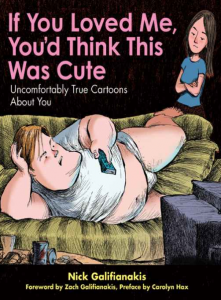Cartoonist Nick Galifianakis explores the intricacies of relationships in his new book and shares some of the details with Washington Life.
By Gabbi Baker
Washingtonians know him best for his clever cartoons that accompany Carolyn Hax‘s advice column in The Washington Post, but now, cartoonist Nick Galifianakis has brought together his best illustrations for his new book, If You Loved Me, You’d Think This Was Cute: Uncomfortably True Cartoons About You. With an invitation-only book party and signing in D.C. tonight as part of his book tour, Galifianakis sat down with Washington Life to give our readers a closer look at the thoughts behind the drawings.
Gabbi Baker: How did you start drawing?
Nick Galifianakis: I probably started the same day you started drawing; we all started drawing when we were little children. It’s just that some of us keep going. I had an interest because I could tell that it was sort of different than how other people would draw, and other people started pointing out that it was different. You do something that makes your parents or teacher “oohh” and “ahh” – that encourages you.
Although I never studied art formally, my father made sure I was around it. He’s a self-taught artist 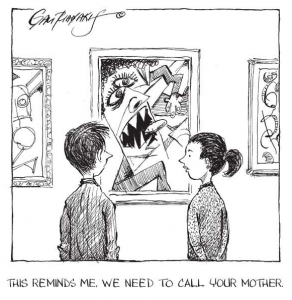 and always took us to museums. I liked looking at art, and I liked looking at the things that made me like looking at it. I always drew, I always looked. I copied, I stole, I made it my own. I didn’t ever take it seriously, but in college, I developed an opinion. I had something to say. And because I had unwittingly created sort of a graphic way to say things, I just married the two and started drawing cartoons and seeing if I could get down to the essence of an issue graphically.
and always took us to museums. I liked looking at art, and I liked looking at the things that made me like looking at it. I always drew, I always looked. I copied, I stole, I made it my own. I didn’t ever take it seriously, but in college, I developed an opinion. I had something to say. And because I had unwittingly created sort of a graphic way to say things, I just married the two and started drawing cartoons and seeing if I could get down to the essence of an issue graphically.
GB: You attended the University of North Carolina in Chapel Hill. What did you major in? What did you think you wanted to be when you grew up?
NG: It wasn’t art. [laughs] I always call UNC a wonderful school that I should have never gone to. Going into college, I had a very strong, and still do, love of medicine. My thought initially was that I would eventually become a doctor, and I still love that stuff.
GB: Art and medicine seem like pretty polar opposites, no?
NG: I don’t know how different they are. They’re different in their expressions, but not at their core because I think that you can be creative in any endeavor. The creative use of knowledge is far more impressive to me than the accumulation of knowledge, somebody who has a string of degrees from here to the end of the street. I’ll tip my hat to them and respect what they’ve done, however, I reserve that bright light for the person who only knows five things but can endlessly rearrange those things to and make you see something new, to see the familiar in an unfamiliar way. And this can happen whether you’re an artist, whether you’re a musician, whether you’re an engineer, whether you’re a cook, whether you’re a doctor – the creative use of knowledge is certainly not exclusive to artists.
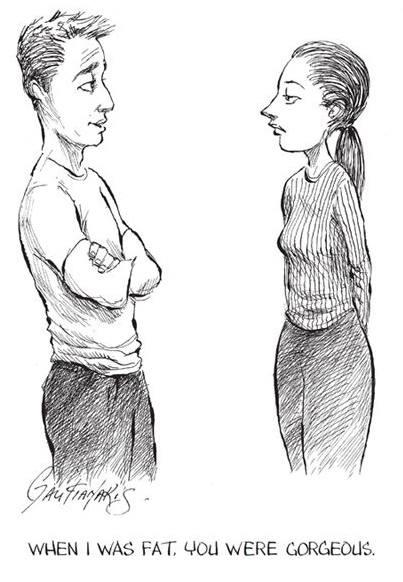 GB: Let’s talk about your book. What was your inspiration for putting it together?
GB: Let’s talk about your book. What was your inspiration for putting it together?
NG: I’ve been illustrating the advice column of the super-brilliant Carolyn Hax for over 14 years, and I’ve had in my mind to put a book together for a long time. I wanted a very large body of work to select from; I wasn’t interested in doing a collection for a particular year and then every year, a new collection. That didn’t do it for me. Instead, I wanted to pick from many years, so hopefully, wherever you open the book, you’re going to get my strongest effort.
GB: Why choose to illustrate relationships?
NG: It’s just the nature of an advice column; it’s what people want to know most about, it seems. If you wander into a palm reader, you’re wondering about your love life. If you’re looking at your horoscope, you want to know about your love life. It’s something that’s always running right under the surface.
GB: How do you and Carolyn communicate to create the finished product for the paper?
NG: Carolyn writes the column and then she sends it to me to edit. I go through the column and write notes, and we go back-and-forth and toss around the column. When that’s done, we toss around the cartoon. It’s very much a team effort. No column has been published without it having run through me and no cartoon without it running through her. She’d great at distilling my ideas because I start running around in long-winded psychological circles – I know what I want to say, what angle I want to attack an issue from, and I start blathering on with words. Carolyn is amazing at getting the best out of that.
GB: How long does it take you to create a cartoon?
NG: There’s no set answer for that. Sometimes the cartoon comes while editing. Sometimes there’s writer’s block and endless pacing. Some ideas pop up instantly. Others need a lot of committed though. It takes work, like anything else…even during a break, it’s always in the back of your mind.
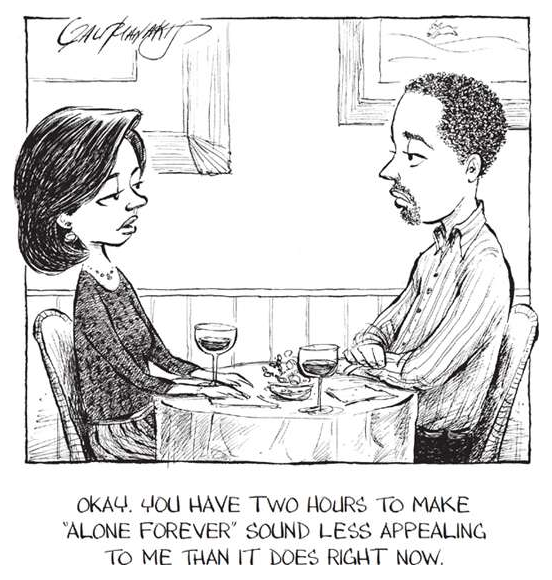 GB: On that note, do you find that you’re constantly observing others, taking mental notes of material for your cartoons?
GB: On that note, do you find that you’re constantly observing others, taking mental notes of material for your cartoons?
NG: Absolutely. An enormous part of the process that, obviously, happens before you sit down at the drawing board. I’m not a cartoonist because I happen to draw better than the next guy. I’m a cartoonist because I have a need to comment on the things that interest me and relationships interest me. I annoy the daylights out of everyone around me with my observations, connecting the dots and seeing patterns. I like looking at the sources of things, what motivates us. There are people who will meet you and will never forget your name or your face, the clothes you wore or your jewelry – they just have a head for those things. I don’t do any of that (other than faces), but I remember how you looked at your boyfriend, or your mom. Were you cut off? Or did you interrupt somebody? Do you say “I” and “me” a lot? Do you make eye contact? How do you tell a story? Do you ask questions or do you listen? And so on and so on. These are the things that I focus on without knowing I’m focusing on them. You notice jewelry, I notice human interaction.
The most fun thing for me when I go out with friends is trying to pick out the people on a first date. And then, in the last few years, I’ve tried to up the game a little bit – try to find the ones that are first from an online dating site. That has a different quality to it.
GB: Like what?
NG: Well, there’s this supposed compatibility right off the bat. One – the fact that they were both on the dating site means that they were looking for somebody and that reveals itself in a variety of ways; politeness and enthusiasm often take on an interesting, not quite natural quality, for example. It’s fun to watch everybody. More established couples, I’ll check the time – it’s been a while since they’ve spoken to each other. Is that a couple that’s really comfortable and is therefore just enjoying their proximity to each other or one that’s bored and moving on. It’s endless; there are a trillion things to see and wonder about – I could be wrong about every single one of them, by the way. I bring my observations back to my drawing board and start distilling. The incredible thing is to see how unique we are not. We’re just not. People respond to a variety of triggers and stimuli similarly – I supposed therapy is built on this idea. In broad strokes, we’re not unique.
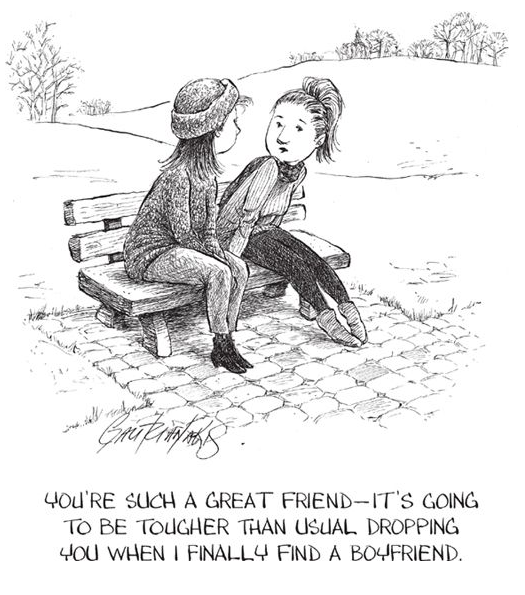 GB: But you do a fantastic job of making the situations in your cartoons relatable, almost to the point that we believe the situation is unique to us.
GB: But you do a fantastic job of making the situations in your cartoons relatable, almost to the point that we believe the situation is unique to us.
NG: Yeah, well, they’re your moments and my moments. We’re sort of walking around on the same planet doing the same things at the same ages hitting similar milestones. There are exceptions all around, but at some point, most everybody is passing through these different stages and so I think you can qualify being relatable as a human being who has met another human being. Hopefully you’ll find something in my cartoons that you can understand.
GB: Tell us about the book tour. How is it going?
NG: I’ve been around the perimeter of the country, avoiding the center until the Spring [because of weather]. Every place is memorable in some way. You walk into some bookstore in a distant city filled with people you’ve never seen before and will probably never see again, and they’re all there to listen to you talk about your book, see you, and get something signed. Each one had it’s own flavor. It’s a unique and warming experience. And then to come back home to Politics and Prose – the place was absolutely packed. I was very moved.
GB: And what are your fans like? Who comes to see you?
NG: It’s an interesting phenomenon with this book. It’s a book of cartoons, of course, but I lobbied hard that it not be promoted as just a book of cartoons. It’s commentary about you – if you can’t find yourself in this book, then you’re not paying attention. To yourself. Very often when books of cartoons or graphic novels are being promoted or sold, the crowd that shows up is cartoon collectors, people who follow a strip, artists, etc. That has been the overwhelming minority for me; with my book, it’s been mostly women – far more women than men – who buy several copies to give to their friends, their boyfriends, their husbands. I’m very warmed by that – they get it. And by “get it,” I don’t necessarily mean purchase it, which they’ve done. I mean they’ll connect to it. They’ll relate to it in the intended way. And that’s been a lot of fun.
Another crowd that shows up are dog people. There are a handful of cultures in the world that are animal and pet crazy, and we’re certainly among them. Those people have come out in force. My dog, Zuzu, became ill during the assembly of the book. Though I had already written another introduction, my focus shifted almost completely, and so I decided that I was going to write about her. I know and love my dog, but I focused on her in a new way and realized that this was a very good, very healthy relationship. That she and I shared fundamentals that should be true of any good, human relationship. People seem to respond to that, so it’s become part of the book presentation. Zuzu passed away in August and I miss her impossibly.
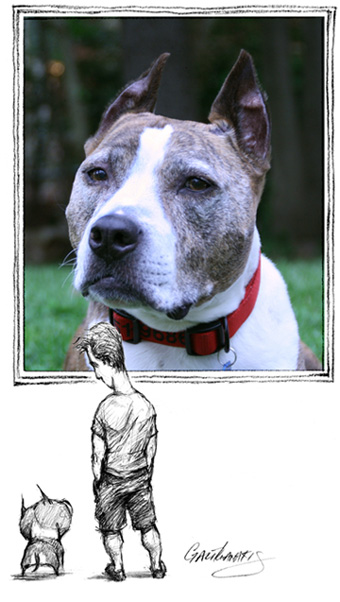 GB: The introduction to the book is a passionate analysis of your relationship with Zuzu. What made your relationship special?
GB: The introduction to the book is a passionate analysis of your relationship with Zuzu. What made your relationship special?
NG: Zuzu and I had a good deal. We loved each other and looked out for each other. We were always happy to see each other no matter how many times a day that happened, we never lied to each other. We had bulletproof trust in each other. We weren’t defensive. And we always thought the best of each other and looked at each other in the best light. We assumed the other had the best intentions. We calmed each other just by being together. We accepted each other “as.” The list goes on. Why can’t you have that with a person? Why are we conditioned to reach a certain age and completely bypass most of those important fundamentals and instead say, “Oh my gosh – I need to get married and have kids!”
I obviously realized that I wouldn’t have Zuzu forever. I had been using her in my cartoons for years. They are easily among my most popular cartoons. But popularity isn’t why I continue to use her. The reason is even more selfish: it keeps her alive, in a different kind of way. Zuzu in my cartoons is ageless, and since she’s usually in those cartoons with me, it’s the one place where the two of us can be together. I don’t think I’ve actually ever said that before. That others enjoy that is a wonderful bonus and important for an artist. A piece of artwork is not finished until somebody has responded to it. It completes the transaction between me and Zuzu.
GB: Finally, I have to ask – we all know your cousin Zach Galifianakis from his hilarious stand-up comedy routines and his role in The Hangover. Comedy clearly runs in the family. What is your relationship like?
NG: When you read the forward [to the book, written by Zach], Zachy goes into how close we are. We’ve both been very supportive of each other since we were kids…we’re close, but there’s a whole bunch of us cousins and we’re all unusually close. We come from a loving family that loves to laugh. None of this ugly stuff in the background – where you the stereotype of the horrific childhood where you use humor to work out your anger. We actually had good parents who still give us hugs and kisses. [laughs] You’re always encouraged in our family. I did a drawing as a child, and everybody made me think I was Picasso. Zach told a joke, and everybody said “you ought to be in the movies.”
GB: Any closing thoughts?
NG: I’m so lucky, so blessed – I work for the paper that I learned how to read in. The Washington Post is where I sharpened my mind as a child, and now I see my work appears there. That’s an incredible thing. As a kid I remember picking up the newspaper and going straight to the comic section; as I got a little older, looking at the sports sections, and then other sections. And now, I go to the end of the driveway knowing of actually contributed something to it. It’s really quite a thing for the little kid in me.
—
All cartoons included in this article can be found in Galifianakis’ new book, If You Loved Me, You’d Think This Was Cute: Uncomfortably True Cartoons About You, and can be purchased by clicking here. You can also click here to view exclusive Washington Life photos from Galifiankis’ D.C. Book Party in March at Lincoln.

